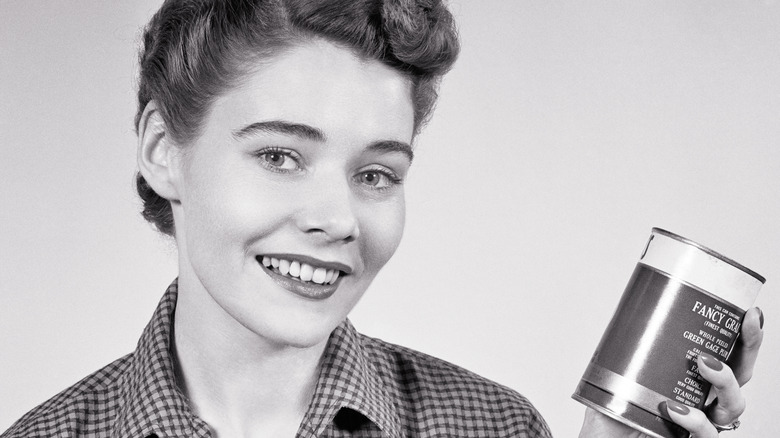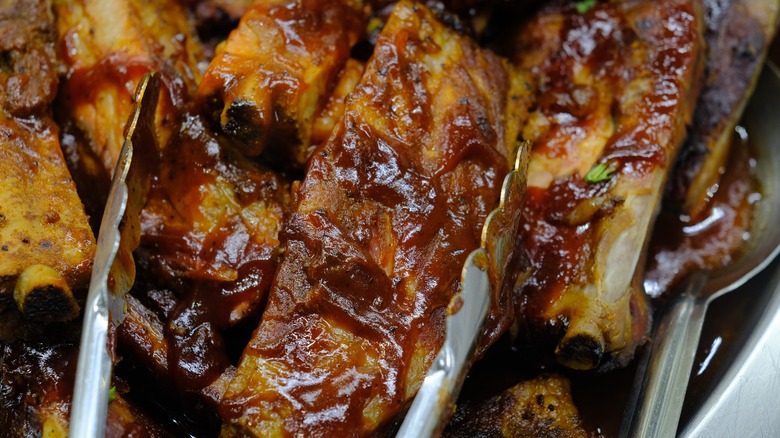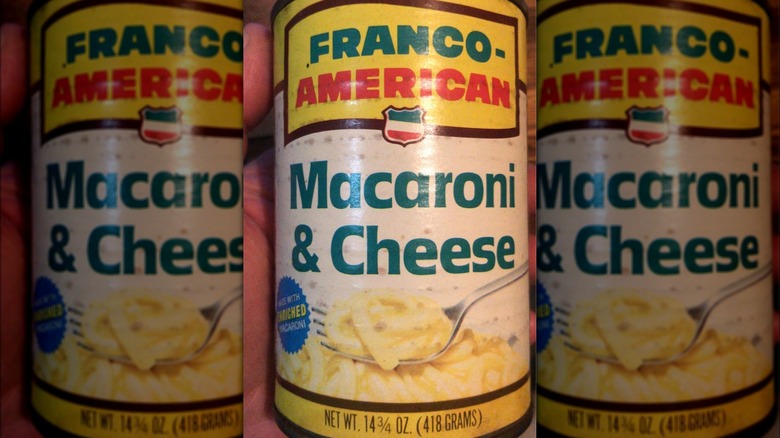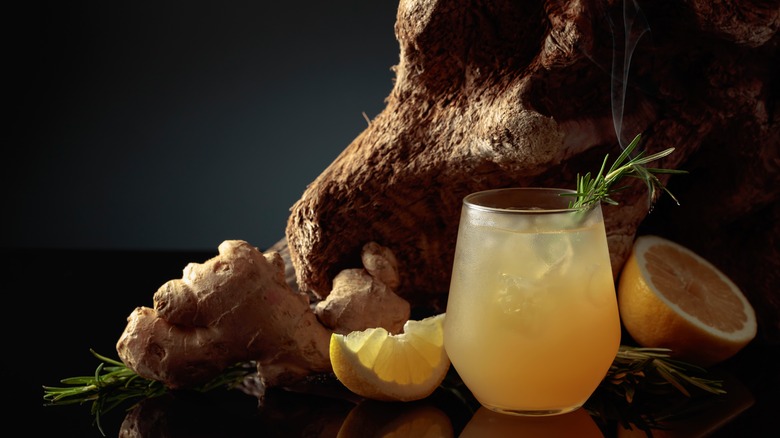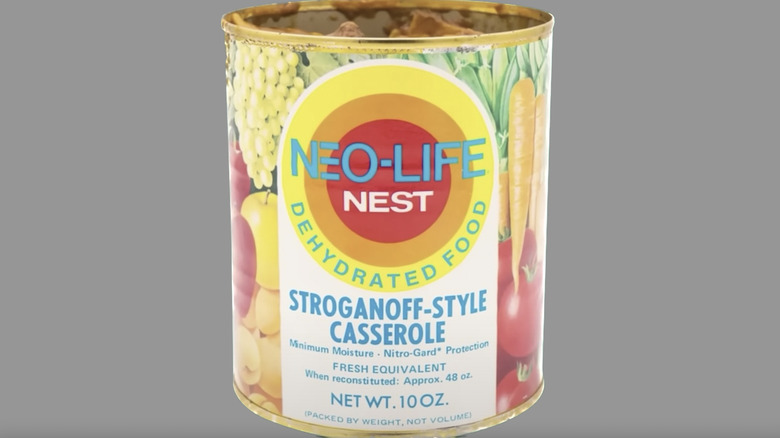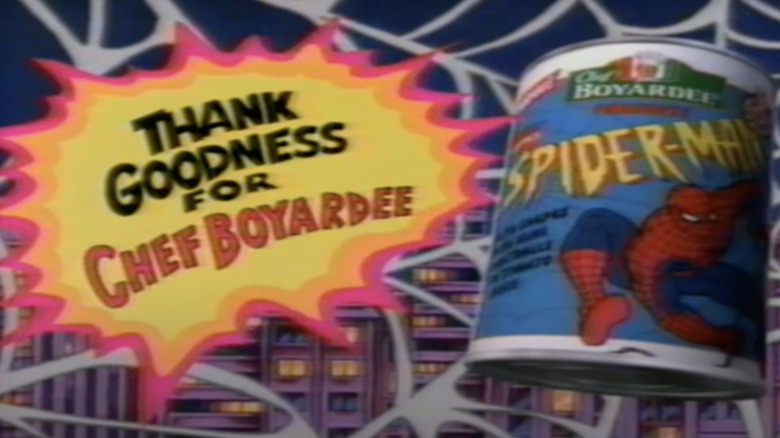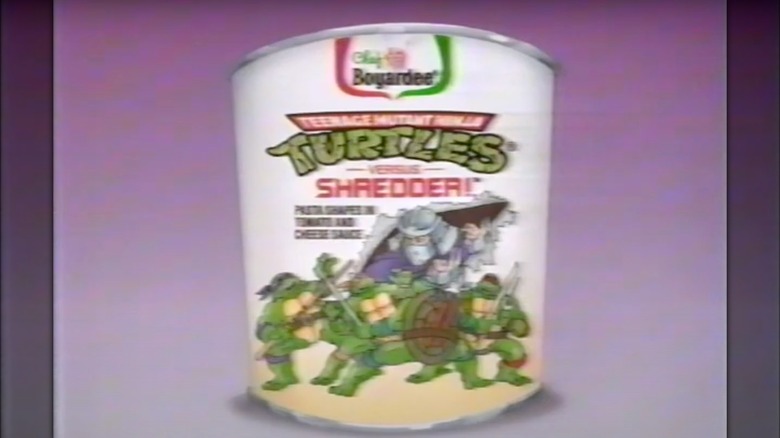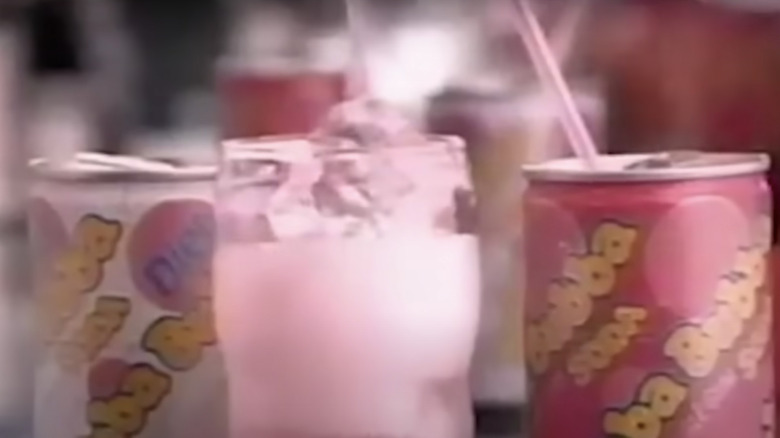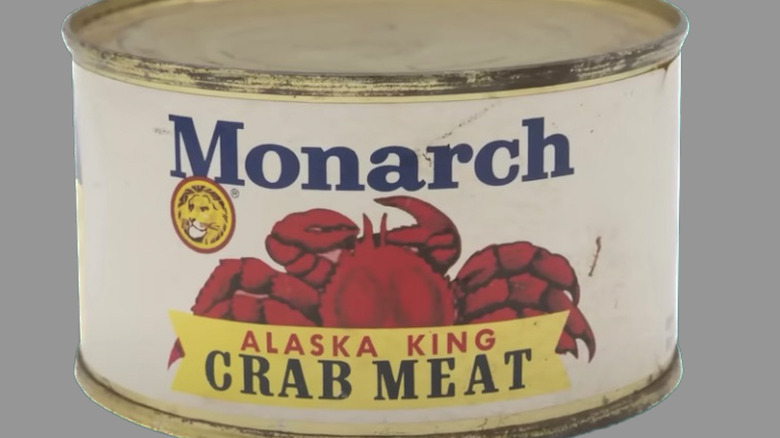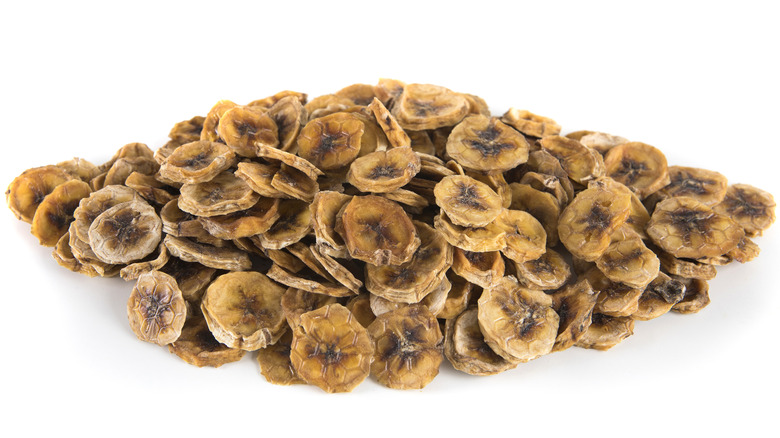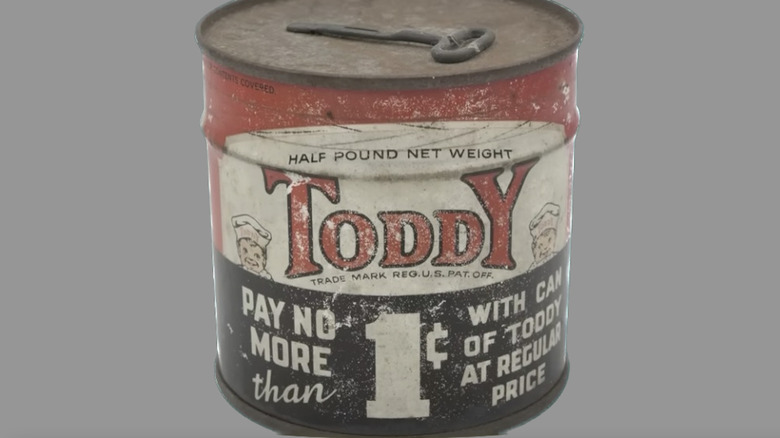10 Vintage Canned Foods And Drinks That Don't Exist Anymore
It is safe to say that most modern food products are not exactly the same as their historical predecessors. Back in the day, people were less concerned about flavor than they were about preserving their food for long periods of time. This was especially true before the refrigerator hit the market. In those times, people dreamed up plenty of elaborate and complicated recipes to make their leftovers last.
During the 1800s, for example, scraps of leftover meat were mashed with mayonnaise to make "salads" much like the modern tuna salad or chicken salad. A similar dynamic brought us the modern tres leches cake. Before refrigeration was common, Nicaraguan cooks would bathe their stale cake leftovers in milk (and previously rum) to make the dessert taste good for one more day.
Not all attempts at food preservation, though, were so delicious. In the year 1810, French inventor Nicolas Appert told the world that by sealing food in a jar and then boiling it, you could prevent the jar's contents from going bad. Following this major discovery, people from across the globe rushed to make new products, ranging from sweetened condensed milk ... to other less savory items. From beef stroganoff to Franco do Amaral Industries' canned banana flakes, these are some vintage canned goods that are best left in the past.
1. Armour Star's BBQ ribs in a can
There is nothing quite like sinking your teeth into a nice juicy rib during the summertime. Thanks to the fatty flavors of the meat and the slight tanginess of homemade BBQ sauce, this spectacular combination is an American classic. Of course, it almost goes without saying that one of the best parts of BBQ ribs is enjoying them fresh off the grill, oftentimes in someone's backyard.
Sadly, though, in 1963, the U.S.-based meat packing company Armour Star tried to serve this traditional outdoor experience in a can. Indeed, the enterprise launched canned ribs with BBQ sauce. Armour Star would cram 2.5 pounds of meat into a can along with some sauce that contained six mysterious spices. Apparently, the producers made an effort to make these ribs taste as fresh as possible, even smoking them before stuffing them into cans.
That being said, there were a few major issues with this product, starting with the fact that the ribs were not deboned before they were canned. An advertisement from the 1960s tried to reassure customers that they were not just paying for a can full of bones, asserting that their ribs were "slim in bone — heavy on the good, rich meat" (via Period Paper). Unfortunately, though, Armour Star canned ribs were hardly the most affordable option available. This likely prevented consumers from investing in this bone-filled product.
2. Franco-American macaroni with cheese sauce
For many Americans, the vintage canned food brand Franco-American evokes childhood memories. Launched in the late 1800s, this brand became famous for providing families ready-to-serve canned dinners that were easy to heat up and throw on a plate. The company sold gravies and pastas — a repertoire that was expanded by Campbell's, which acquired Franco-American in 1915.
For many years, one of the most successful Franco-American products was its canned macaroni with cheese sauce. According to one 1956 advertisement, the proper way to serve this unique macaroni and cheese product was by baking it in a casserole under a layer of buttered bread crumbs (via Pinterest). Apparently, both milk and butter were on the can's ingredients list, as well as aged Cheddar cheese. In the words of the company, it tried to use "the same sort of ingredients you would select" to make the macaroni taste homemade. However, while many consumers enjoyed this product, it was hardly fair to compare it to real baked macaroni and cheese.
Ultimately, the Franco-American brand and products – including macaroni with cheese sauce — were phased out starting in 2004. The reason for this was that consumers eventually stopped reaching for Franco-American pasta in the supermarket aisle, opting for Chef Boyardee instead. Although this product failed to maintain its overall popularity, it left behind a small yet zealous group of fans that continues to petition for its return.
3. Clicquot Club ginger ale
If the name Clicquot Club does not sound familiar to you, don't worry — you are not alone. In 2023, only a few folks remember this old soda company, even though it was iconic in its era. In fact, according to a report by the Boston Globe, there was actually a time when Cliquot Club was the biggest ginger ale producer in North America. Of course, though, that time has long passed — Cliquot Club was in its heyday about ninety years ago.
The brand is believed to have started out in the 1880s at an apple orchard in New England. Known as the LaCroix Fruit Farm, this business was a Millis family enterprise that occasionally produced sparkling apple cider. Over time, the business expanded to include classic sodas, like birch beer, orange soda, and — their most popular product — ginger ale. The family named its brand Cliquot Club as an homage to France's Veuve Cliquot champagne, and the product slowly became a sensation.
One of the main reasons for Cliquot Club's initial success was that it used high-quality ingredients. The Milford Daily News reported that the late Cliquot Club collector, Hindy Rosenfeld, once recalled, "The ginger ale had a champagne-like quality." Unfortunately, though, the rise of colas like Coke and Pepsi, along with changing consumer tastes, contributed to this soda's decline.
4. Neo-Life Nest dehydrated stroganoff casserole
While many vintage canned food brands hoped to preserve their eats for months or years, one company sought to keep its goods fresh for decades. Neo-Life Nest's dehydrated food brand used its "nitro-gard" protection to preserve its meals as long as possible. This brand tried to shoot a bit of nitrogen into each can in an attempt to prevent the food inside from deteriorating over time. This technology was, ultimately, applied to Neo-Life Nest's dehydrated stroganoff-style casserole, meaning that the food could be, ostensibly, consumed for decades after it was packaged.
Interestingly, this unique production strategy made stroganoff-style casserole a favorite among survivalists. Back in the 1970s, Neo-Life sold this product in bulk to folks across the United States, sometimes even in quantities large enough that they were said to last a full year for one adult. Unfortunately, however, not everybody who purchased this unusual meal understood one key factor — the nutritional value of canned goods decreases with time. In fact, as revealed by Healthy Canning, just the boiling process alone decreases an initial quantity of vitamins. Then, while the food is being stored, these essential elements decrease further.
As a result, in the event of an apocalypse, stroganoff-style casserole wouldn't offer much more than taste. And, as Rhett McLaughlin shared on the Good Mythical Morning YouTube show, this might not have been the product's strength. He even went so far as to claim, "It smells like a dog that's been in a storm."
5. Chef Boyardee Spiderman pasta
Many Americans grew up eating canned pasta in the shape of letters of the alphabet, but in the 1990s, some kids got to enjoy noodles that resembled some of their favorite elements from Spiderman. In 1995, the brand Chef Boyardee launched a limited edition can of pasta and meatballs doused in tomato sauce. Most excitingly, the can was full of pasta shaped like Spiderman and his webs. One billboard posted on Flickr reveals that the company promoted the product by claiming it was "so hot, it's practically radioactive." Meanwhile, TV commercials advertised this special pasta directly to children, using cartoon images to draw the interest of young viewers.
While this particular vintage canned food left many young shoppers with vivid memories, the product did not ultimately age well — literally. In 2020, Chef Boyardee's Spiderman-themed eats started to make headlines for the first time in two decades after a viral Twitter post revealed the treat's unsavory side. A user with the handle @DinosaurDracula opened a twenty-five-year-old can of noodles to reveal a dry web of pasta that had completely evaporated into a small pile of gunk. Despite the overall disintegration of the product, though, some of the noodles maintained their original shape. One even continued to resemble Spiderman, even as its color and consistency had changed substantially.
6. Chef Boyardee Mutant Ninja Turtles noodles
During Chef Boyardee's era of limited-edition noodles, Spiderman-shaped pasta was not the only product that the company sold in cans. In 1991, two types of pasta shaped like the Teenage Mutant Ninja Turtles hit supermarkets across the United States as well. Much like the later Spiderman product, the Teenage Mutant Ninja Turtles pasta offered noodles that resembled some of kids' favorite heroes. However, different from the future product — which stuck to one flavor — this one came with both a vegetarian and a meat option. The purple can contained pasta with mini meatballs dressed in tomato sauce, while the white can simply had noodles in tomato and cheese sauce.
While it is probably fair to say that neither of these two pasta products could compete with a real Italian nonna, they both brought some truly unique vintage cans into the world. Regardless of which flavored pasta you selected, the can would come with a vibrant illustration on its front. Perhaps as a reference to the way that the shaped pasta brought the Teenage Mutant Ninja Turtles to life, both cans featured Shredder cutting his way out of the aluminum and making his way into the real world. Meanwhile, the four main characters were drawn with their swords in hand, ready to head to battle. Like the food or not, these old cans added quite a bit of color to the dinner table.
7. Hubba Bubba soda
These days, Hubba Bubba is known as a popular brand of a chewing gum. However, back in the 1980s, it had a different connotation as well. Hubba Bubba launched a soda in 1987, bringing that classic bubblegum flavor to a fizzy can of pop. Interestingly, though, this hot pink soda was not originally created nor owned by the chewing gum company. In fact, the product was the brainchild of film producer, Steve Roeder, who used snow cone syrup mixed with club soda to come up with the flavor. Thrilled with his invention, Roeder went to Wrigley to secure the rights to the Hubba Bubba name. A new novelty soda was born.
Interestingly, however, Hubba Bubba was a little bit different from other novelty drinks, such as Orbitz soda or Jones Thanksgiving soda. Unlike these drinks, which were packaged in glass collectors' bottles, Hubba Bubba was primarily sold in bright pink cans. It also came in both original and diet versions — similar to a mainstream sodas like Coke or Pepsi.
Ultimately, Hubba Bubba did not have what it took to compete with other major soda brands and it fizzled out by the early 1990s. Some people have hypothesized that its flavor was just a bit too overwhelming for most consumers to buy on the regular. Certainly, it would have been hard to pair Hubba Bubba with, say, pizza or a burger.
8. Monarch Alaska king crab
In 2023, Alaskan king crab is regarded as a sort of a delicacy. King crab meat can cost as much as $50 per pound — and for good reason. Not only does this treat offer a light and delicate flavor, but it is also famously difficult to harvest. Thanks to a laborious, and oftentimes dangerous, fishing process, people have to pay top dollar to get their hands on some high-quality Alaskan king crab meat. Transportation costs also tend to drive the cost up, as most of the crab is frozen up in Alaska before it is sent across the world.
Back in the days before flash freezing, there was a different way that most Alaskan king crab was preserved. For a long while, canning was the most practical way to send premium crab meat from the Alaska to dinner tables everywhere. Monarch was one vintage canned food brand that actively made this type of product. This company was in business around 90 years ago and really seemed to do its best to maintain the high quality of this delicacy, even as it was sealed in cans.
One YouTube video by Good Mythical Morning revealed just how chic a 1930s can of Alaskan king crab was. The texture of the meat was soft and flaky — exactly as it should be. The can even contained whole claws. However, when flash freezing was invented, king crab meat was conserved even better.
9. Banana flakes by Industrias Franco do Amaral
Canned bananas aren't exactly the most common item to find at supermarkets — and it's not because Americans don't love bananas. On the contrary, plenty of consumers adored canned bananas for years. The Brazilian company, Industrias Franco do Amaral, used to produce canned banana flakes that were shipped all over the world, bringing the fruit's sweet flavor to households in Brazil and the United States alike.
As relayed in the artwork of one vintage can that appears on YouTube, the banana flakes sold in the U.S. were marketed as "pure tree-ripened dehydrated bananas." The Brazilian version, meanwhile, was promoted as an ingredient in baby food — with a child's image appearing on the can. Apparently, parents were supposed to mix one or two spoonfuls of conserved banana flakes with milk and sugar to make a nutritious snack for their children. Of course, that was far from being the product's only use, and Industrias Franco do Amaral suggested using this product in multiple ways. The old Brazilian cans even instructed consumers to try out the product in puddings and milkshakes.
10. Canned Toddy chocolate milk
Many years ago, a cold winter's day would mean cozying up by the fire with a cup of Toddy in your hand. And, no, we aren't talking about a hot toddy cocktail with whiskey and brown sugar. We are referring to Toddy brand chocolate drink in a can.
In 1919, an American man by the name of James William Rudhard developed Toddy as a way to make drinkable food. Unlike other sweet drinks at the time, which had little to no nutritional value, Rudhard's invention sought to incorporate all of the vitamins and minerals available in malted milk, pair them with sweeteners, and make them easy to conserve over long periods of time. Thanks to Rudhard's delicious sugar-filled recipe, the drink quickly became successful. Interestingly, it grew particularly popular in Latin America, where canned milk products represented an easy solution to preserving this nutrient-rich food in warm weather.
These days, Toddy remains on the Latin American market, where it exists as a PepsiCo-owned chocolate drink mix, as opposed to canned milk. However, the unique design of the old Toddy cans reveals that this product was probably one of the coolest items on the market. Toddy's vintage cans came with literal keys fused to the top. These could be used to unlock the old cans, providing consumers with a way to access the milk even if they didn't have a can opener at home. This fun yet practical packaging strategy likely contributed to the brand's success.
